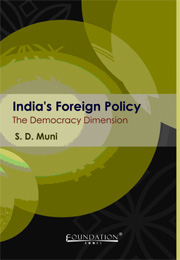Book contents
- Frontmatter
- Contents
- Preface
- 1 Introduction
- 2 The Nehruvian Phase: Ideology Adjusts with Realpolitik
- 3 Nehru's Successors: Realism Takes Command
- 4 Imperatives of the New Millennium
- 5 An Overview
- Appendix I Warsaw Declaration on Community of Democracies, June 2000
- Appendix II Santiago Commitment; Community of Democracies, April 2005
- Appendix III PM's Address to Joint Session of the US Congress, July 2005
- Appendix IV PM's Speech at the Foundation Stone Laying Ceremony of Afghan Parliament, August 2005
- Appendix V PM's Speech at the UN Democracy Fund, September 2005
- Appendix VI PM's Speech at the Conference on Democracy, Development and Social Inclusion, December 2005
- Index
2 - The Nehruvian Phase: Ideology Adjusts with Realpolitik
Published online by Cambridge University Press: 26 October 2011
- Frontmatter
- Contents
- Preface
- 1 Introduction
- 2 The Nehruvian Phase: Ideology Adjusts with Realpolitik
- 3 Nehru's Successors: Realism Takes Command
- 4 Imperatives of the New Millennium
- 5 An Overview
- Appendix I Warsaw Declaration on Community of Democracies, June 2000
- Appendix II Santiago Commitment; Community of Democracies, April 2005
- Appendix III PM's Address to Joint Session of the US Congress, July 2005
- Appendix IV PM's Speech at the Foundation Stone Laying Ceremony of Afghan Parliament, August 2005
- Appendix V PM's Speech at the UN Democracy Fund, September 2005
- Appendix VI PM's Speech at the Conference on Democracy, Development and Social Inclusion, December 2005
- Index
Summary
Nehru was a great democrat but his democratic moorings, in practical policy terms, were tempered by various other considerations when it came to evolving India's foreign policy in general and the neighbourhood policy in particular. To begin with, there was a strong British imperial legacy of fortifying India's defence and promoting as well as protecting India's security in the sis Himalayan region. A perceptive columnist has described Nehru as a ‘Democratic Curzon’. Nehru could be accused of a Curzonian mindset on security issues but he was not in the same advantageous position as Curzon when it came to India's geo strategic assets. In a very critical sense, the British strategic vision of India and its security was breached by the partition as it created India's geostrategic disconnect with Afghanistan and Central Asia to Pakistan's advantage. That was perhaps one of the reasons why Britain persuaded the US to have an alliance with Pakistan to command the Central Asian geo strategic space. Pakistan, rather than remaining a part of the British Indian core, became a security concern for independent India. The evolving consequences of the partition also redefined India's northern security in the context of Sino Pakistani collaboration. With an eye on clipping India wherever possible, this collaboration also led to Pakistan ceding away in 1963 a part of Kashmir's territory to China. The framework of India's neighbourhood security was also radically altered by the rise of the communists in China after 1949.
- Type
- Chapter
- Information
- India's Foreign PolicyThe Democracy Dimension, pp. 29 - 54Publisher: Foundation BooksPrint publication year: 2009



